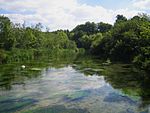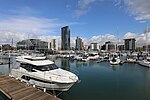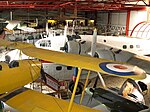Itchen Bridge

The Itchen Bridge is a bridge over the River Itchen in Southampton, Hampshire. It is a high-level hollow box girder bridge. It is located about a mile from the river mouth. The bridge spans 870 yards (800 m), is 92 feet (28 m) at its highest point and weighs 62,000 tons. The bridge connects the A3025 Portsmouth Road to Southampton. It was built to replace the former chain ferry, known as the Floating Bridge, that crossed the river at that point. The bridge's set of blue energy-saving lights can be seen from up to 5 miles (8.0 km) down Southampton Water from the bridge. The bridge has achieved notoriety as a venue for suicide, with over 200 alleged suicides recorded since its opening in 1977, prompting calls for the construction of preventive measures along its length.
Excerpt from the Wikipedia article Itchen Bridge (License: CC BY-SA 3.0, Authors, Images).Itchen Bridge
Floating Bridge Road, Southampton St Mary's
Geographical coordinates (GPS) Address External links Nearby Places Show on map
Geographical coordinates (GPS)
| Latitude | Longitude |
|---|---|
| N 50.8988 ° | E -1.3847 ° |
Address
Itchen Bridge
Floating Bridge Road
SO14 3FL Southampton, St Mary's
England, United Kingdom
Open on Google Maps









